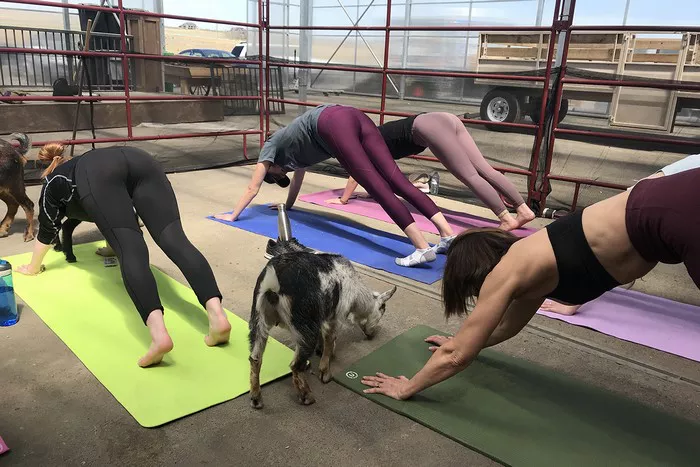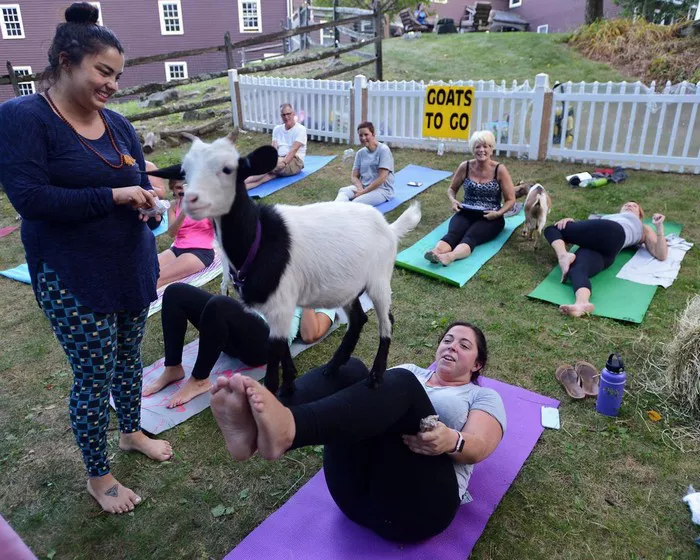In recent years, goat yoga has taken the wellness world by storm. This unique practice combines traditional yoga with the playful energy of goats. It has captured the hearts of many, drawing people to farms and studios to experience this delightful fusion. But what is goat yoga, and is it truly beneficial? In this article, we will explore the concept of goat yoga, its benefits, and any potential drawbacks.
What Is Goat Yoga?
Goat yoga is a blend of yoga and animal therapy, featuring adorable goats roaming freely during a yoga session. Participants practice various yoga poses while goats interact with them, often climbing on their backs or snuggling up beside them. This unusual approach aims to promote relaxation and joy. The goats add an element of fun and spontaneity to the practice, making it accessible to people of all fitness levels.
The trend began in 2016 when a goat farm in the United States started offering yoga classes with baby goats. Since then, it has spread rapidly, with many studios and farms incorporating it into their offerings. Goat yoga sessions typically take place outdoors, allowing participants to enjoy nature while practicing mindfulness.
The Benefits of Goat Yoga
1. Stress Relief
One of the most significant benefits of goat yoga is its ability to reduce stress. Yoga itself is known for its calming effects, helping to lower cortisol levels and promote relaxation. The addition of goats enhances this experience.
Watching the playful antics of goats can lighten your mood. Their innocent curiosity and playful behavior encourage laughter, which is a natural stress reliever. Participants often leave goat yoga sessions feeling more relaxed and happy.
2. Increased Mindfulness
Goat yoga promotes mindfulness, a core principle of traditional yoga. Mindfulness involves being present in the moment and fully engaging with your surroundings. The presence of goats encourages participants to focus on their immediate environment rather than their daily worries.
As goats wander around, you become more attuned to your surroundings. You may find yourself laughing, petting a goat, or simply enjoying their company. This heightened awareness can lead to a deeper connection with your practice and a greater sense of peace.
3. Improved Social Interaction
Goat yoga is often practiced in groups, making it a social activity. Many people find community and camaraderie in these classes. Participants share laughs and experiences, forming bonds over their shared love for yoga and animals.
Social interaction is vital for mental health. Engaging with others can alleviate feelings of loneliness and isolation. Goat yoga offers a fun, relaxed atmosphere that fosters connections with like-minded individuals.
4. Physical Benefits
Like any form of yoga, goat yoga provides physical benefits. Practicing yoga improves flexibility, strength, and balance. The added element of goats can challenge your stability and core strength, as they may climb on you or nuzzle for attention.
While you may be laughing and playing with goats, your body is still working. Holding poses while a goat sits on your back requires focus and strength, providing a workout that is both fun and effective.
5. Connection with Animals
For animal lovers, goat yoga offers a unique opportunity to connect with animals in a therapeutic setting. Animal therapy has been shown to reduce anxiety and improve overall well-being. The gentle presence of goats can provide comfort and joy during your practice.
Spending time with animals releases oxytocin, a hormone associated with bonding and happiness. This emotional connection can enhance your yoga experience and promote feelings of warmth and positivity.
6. Encouragement of Playfulness
Goat yoga encourages participants to embrace their playful side. The unpredictable nature of goats adds an element of fun to the practice. This lighthearted approach can help you release tension and let go of perfectionism.
Many people take yoga too seriously, focusing on achieving the perfect pose. Goat yoga shifts the focus from competition to enjoyment, reminding participants that yoga is about self-discovery and playfulness.
7. Unique Experience
Lastly, goat yoga offers a unique experience that sets it apart from traditional yoga classes. It is not just about exercise; it is about creating lasting memories. The joy of practicing yoga with friendly goats is an adventure that many people cherish.
This novelty can inspire individuals to explore their yoga journey further. It may encourage them to try different styles of yoga or return to more traditional classes with a renewed sense of enthusiasm.
Potential Drawbacks of Goat Yoga
While goat yoga has many benefits, it may not be suitable for everyone. Here are some potential drawbacks to consider:
1. Allergies and Sensitivities
For individuals with allergies to animals, goat yoga may not be the best choice. The close interaction with goats can trigger allergic reactions in some people. If you have a history of allergies to animals, it is essential to consult your doctor before trying goat yoga.
2. Distractions
The playful nature of goats can be distracting during yoga practice. If you are looking for a quiet and meditative experience, goat yoga might not provide that. Some participants may find it challenging to focus on their practice with goats climbing on them or making noise.
3. Safety Concerns
While goats are generally gentle animals, there is always a risk of injury in any physical activity. Participants should be aware of their surroundings and mindful of the goats’ behavior. If you are hesitant around animals or have concerns about safety, it may be better to opt for a traditional yoga class.
4. Not a Substitute for Traditional Yoga
Goat yoga can be a fun and enjoyable experience, but it should not replace traditional yoga practice. While it offers benefits, it does not provide the same depth of practice and concentration that traditional yoga does. It is essential to balance goat yoga with other forms of yoga to maintain a well-rounded practice.
See Also: Why Do Goat Yoga?
How to Prepare for Goat Yoga
If you decide to try goat yoga, here are some tips to help you prepare:
1. Dress Comfortably
Wear comfortable clothing that allows for movement. Choose materials that breathe well, as outdoor sessions can get warm. Avoid overly loose clothing that may interfere with your poses or get caught on the goats.
2. Bring a Mat
Most goat yoga classes provide mats, but it’s a good idea to bring your own. Your mat will create a familiar space for your practice and provide some cushioning on the ground.
3. Stay Hydrated
Drink plenty of water before and after your class. Hydration is essential for maintaining energy and focus during yoga. Ensure you stay hydrated, especially if you are practicing outdoors in warm weather.
4. Approach with an Open Mind
Goat yoga is all about fun and relaxation. Approach the class with an open mind and a sense of humor. Allow yourself to be playful and enjoy the experience, even if it doesn’t go exactly as planned.
5. Follow Instructions
Listen to your instructor’s guidance during the class. They will provide tips on how to interact with the goats and maintain your safety. Following their instructions will help you get the most out of your experience.
Conclusion
In summary, goat yoga can be a delightful and beneficial experience for many. It combines the stress-relieving aspects of traditional yoga with the playful energy of goats. Participants often report feelings of joy, relaxation, and improved social connections after attending goat yoga classes.
However, it is essential to consider potential drawbacks, such as allergies or distractions. Goat yoga may not be for everyone, but for those who are open to the experience, it can be a unique addition to their wellness journey.
If you are looking for a fun, memorable way to practice yoga, goat yoga might be just what you need. Embrace the opportunity to connect with animals, meet new people, and enjoy a light-hearted approach to your practice. Whether you are a seasoned yogi or a complete beginner, goat yoga can offer a fresh perspective on wellness and joy.
Related topics:



















